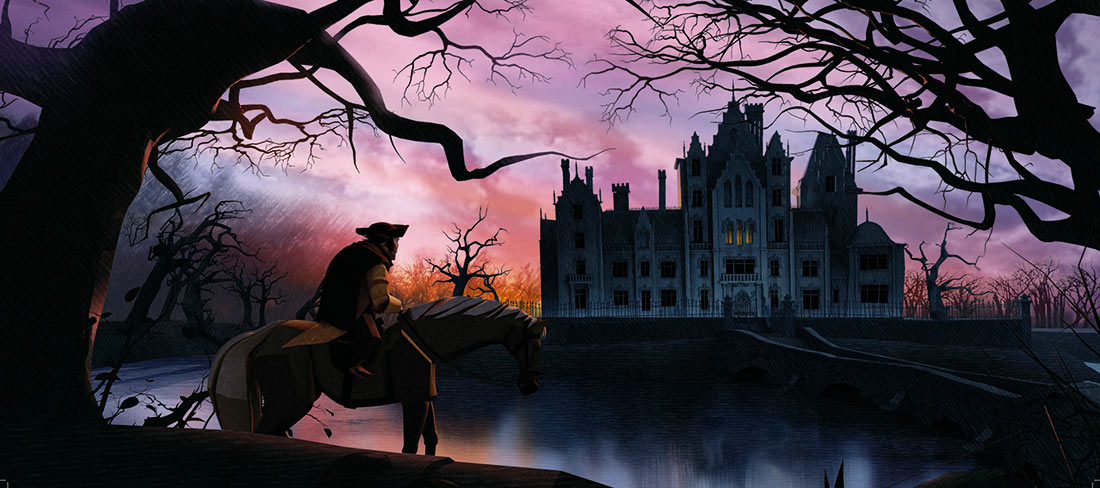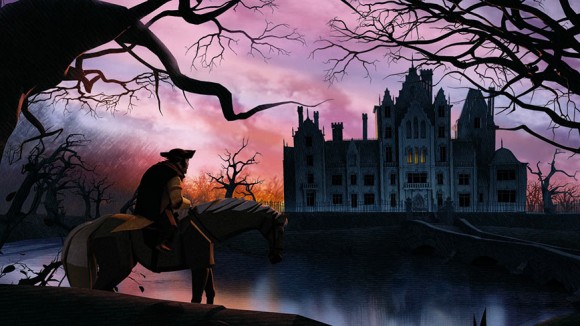

Nine Years in the Making, Raul Garcia’s Poe Anthology ‘Extraordinary Tales’ Has Arrived
Bleeding into theaters and video-on-demand platforms in time for Halloween, director Raul Garcia’s Extraordinary Tales is an animated anthology of Edgar Allen Poe’s stories that’s as stylistically diverse as it is existentially engrossing.
Starring voices of the late, great Christopher Lee, the iconic Bela Lugosi (from beyond the grave), filmmaker Guillermo Del Toro, B-movie influential Roger Corman, and veteran horror and fantasy actor Julian Sands, Extraordinary Tales brings Poe’s harrowing stories to the screen for newer generations raised on boundless technologies and influences. Opening last Friday, Garcia’s 73-minute, unrated animated anthology ambitiously pulls art, literature, comics, film, and collaboration into its dark embrace and doesn’t let go.

Much of its adaptive spirited comes from Garcia’s youth, which was spent voraciously reading and watching horror, fantasy, and sci-fi, as well as decades spent animating features like Who Framed Roger Rabbit, Aladdin, The Hunchback of Notre Dame, Fantasia 2000, and more. Marking his feature directorial debut, Extraordinary Tales is a dark dream come true for the animator, nine years in the making. Cartoon Brew spoke at length with Garcia via email about reanimating Poe from the page to the screen, and collaborating across countries and technologies to bring his nightmarish vision to compelling life.
For more information on how to see the film, which is released by GKIDS in the United States, see the film’s Facebook page.
Cartoon Brew: Death and the Raven speak of obsession and inspiration in your film’s prologue.
Raul Garcia: Obsession is definitely one of the terms that could well define this project. Edgar Allan Poe was one of the first grown-up authors I read when I was a kid, and graduating to his dark atmosphere certainly made a big impression on me. I was an avid reader, and once I entered the realms of horror, fantasy, and sci-fi, I couldn’t stop reading horror comics, or watching fantasy and science-fiction films. I eventually built up a taste for genre.
Cartoon Brew: Why were you drawn to this project?
Raul Garcia: I’ve always been drawn to animation, as I grew up on a steady diet of Warner Bros. cartoons and Disney films. But I always wondered why animated films had to be for kids, and why few thought of making animated horror films. Once I discovered Disney’s Fantasia and Ted Parmelee’s classic animated short, The Tell-Tale Heart, I realized that there was a path for me to explore.
I love classical animation, and had a great time working at Disney and learning from the best animators in the world, but I always harbored another, more experimental side, willing to try new ways to make animation that I have finally been able to explore. We have to remember that animation is a technique not a genre, so horror is as good as any other genre for animation.
Cartoon Brew: You mentioned Parmelee’s classic. Any thoughts on Poe’s previous adaptations, which your film has joined? It’s quite a tradition.
Raul Garcia: UPA’s The Tell-Tale Heart really made an impression on me, enough to dare me to make my own adaptation! I was probably 15 years old when I saw a tattered 16mm print of it, in a time prior to DVDs or the Internet. It left me speechless. I also loved all of Roger Corman’s adaptations of Poe’s work with Vincent Price, even if, in most cases, his films only shared their title with Poe’s originals. I was so obsessed that, when Vincent Price came to Spain for a film festival, I dared to ask him if he could help voice my own version of “The Tell-Tale Heart” — although at the time my English was pretty broken and I was just starting to professionally animate. So the dream of adapting Poe to animation has been brewing in my mind for quite a while.
Cartoon Brew: Can you talk about how obsession and inspiration play into Extraordinary Tales?
Raul Garcia: Unintentionally, I ended up making a film that pays homage to all my artistic and cinematic influences and tastes. All started with “The Tell-Tale Heart,” the first story I co-produced and directed just as a simple short, without any intention of it becoming part of a feature film. The short adapted the style of my favorite comic book artist, Alberto Breccia, a real genius. After that, instigated by Stephan Roelants from Melusine productions in Luxembourg, we decided to try to make a feature film, so “The Fall of the House of Usher” became our second segment, inspired by the art of Jiri Trnka, Edvard Munch, and George Grosz.
After that, I set up a series of rules to follow for the remainder of the film. The first rule was to get as close to Poe’s original as I could, and the second was to try to get narrators who are key players in the fantasy and horror universe. The third rule was to create different styles that would still work with the spirit of Poe’s stories, which allowed me to explore non-photographic rendering styles that could help Extraordinary Tales stand apart from the sameness plaguing today’s commercial feature animation. So “The Facts in the Case of M. Valdemar” was made in the style of EC Comics horror of the ’50s; “The Masque of the Red Death” was made with the art of Egon Schiele and Pieter Bruegel in mind; and “The Pit and the Pendulum” became an homage to the art of Francisco Goya and Giovanni Battista Piranesi, as well as the early photographs of Nicéphore Niépce. Actually, “The Pit and the Pendulum” was the hardest segment to make, as its style is completely photorealistic and its animation very close to live-action, which are two traits of modern animation that I actually hate. But I wanted to experiment, to figure out how realistic and subtly could we animate a character, key framing all movement without using any motion-capture or live-action reference, but still portray emotions and personality.

Cartoon Brew: What software and hardware did you use to make Extraordinary Tales? Can you tell us about your production process?
Raul Garcia: The film was made with normal commercial software packages, like 3ds Max, Photoshop, Premiere and After Effects. We used some toon shader plug-ins to pull the line from some of the animations, but other than that everything was standard software. Technology has changed so much in the nine years it took me to make Extraordinary Tales; I started “The Tell-Tale Heart” in 35mm, and ended up making all the film in digital. But that’s the beauty of technology: We were able to coordinate teams of artists from all over the world, and still maintain the quality and pipeline of the process. Even while storyboarding, we were still going back and forth between plain pencil and paper and graphic tablet. We adapted quite fast to whatever technology was available to make the film.
Cartoon Brew: The voice cast is wonderful. How did you manage to resuscitate Bela Lugosi from beyond the grave?
Raul Garcia: I’ve been collecting Poe’s works on tape for a long time. One day on eBay, I came across a pretty bad recording of Bela Lugosi reading “The Tell-Tale Heart” on cassette, which I had to restore and clean as much as the technology allowed me to in 2006, then secure the rights to use it. Thanks to Bela G. Lugosi, the mythic actor’s son, I was allowed to incorporate the recording into my film.
Cartoon Brew: How about the others? Are they Poe fans?
Raul Garcia: All of the film’s voice cast share love of Poe’s work. After Lugosi, the most logical actor for Extraordinary Tales was Sir Christopher Lee, and after him, Julian Sands. Guillermo del Toro and Roger Corman were perfect choices for their stories, and showed a genuine enthusiasm to be part of the film and share their love of Poe. The voice of Death was performed by Cornelia Funke, writer of the Inkheart book trilogy and the Mirrorworld series. I was so captivated by her voice while listening to her read excerpts of Inkheart to a mesmerized audience of kids that I had to ask her to be part of the film. I am so grateful that everyone was so generous with their talent and time.
Cartoon Brew: You spoke to Cartoon Brew about Lee before, but do you have any additional thoughts on his performance?
Raul Garcia: Sir Christopher Lee was 89 when I recorded his narration, and he wasn’t initially interested in going back to recreate any of Poe’s work. His focus at the time was on a musical career as the singer of Charlemagne: By the Sword and the Cross, his heavy metal opera based on the life of Charlemagne. It was quite complicated to convince him to do Extraordinary Tales, but when I presented him with the film’s artwork, he evidently saw something special in it and decided to help out with the project. Somehow, he became the film’s unofficial ambassador! The only problem was that he didn’t really want to go into a recording studio, so we had to improvise a makeshift studio at his home.

Cartoon Brew: Extraordinary Tales seems to be quite the collaborative effort. What were the challenges and successes in getting it made?
Raul Garcia: I was very fortunate to have an incredible dedicated team of artist from Studio 352 in Luxembourg, but the production was spread all over the world. The film is a co-production between Luxembourg’s Melusine Productions, Belgium’s The Big Farm, Spain’s Melón Digital, and America’s R&R Communications. At the end, we even had a team of people at Mexico’s Boxel helping out with one of the sequences for “The Pit and the Pendulum.” The studio in Belgium dealt exclusively in compositing and rendering, optimizing all the computing processes. We recorded Sergio de la Puente’s music in Bratislava, with soloists playing in Madrid, and mixed the soundtrack in Bilbao before finishing a final mix in Brussels. It was an exercise in coordination.
But thanks to the Internet, we could manage a pipeline of elements from Los Angeles to Luxembourg. Special mention should go to Fabien Renelli, who keep Extraordinary Tales’ machine well-oiled, as well as to my assistant director, Cedric Gervais, who was vital in the process of coordinating everything and finding the perfect way to implement the look of each film, while keeping the animation’s quality consistent.
Cartoon Brew: What advice would you give to someone adapting a literary classic into anthology animation?
Raul Garcia: For me, the important part of the entire creative process is to give every artist the freedom to contribute in a creative way. I firmly believe animation is a team effort. If the film is bad, it’s always the director’s fault. But if it’s good, it is the team who should get the glory. In the case of Extraordinary Tales, I had a really great core team. Over nine years of production, we really learned how to work with each other.
The team wasn’t very large, but its contributions were huge. Denis Figueiredo, Stéphane Lecocq, Toni J.Santamaria, Vanessa Thieffry, and Vincent Brigode are some of Extradordinary Tales’ unsung heroes, although I hate to leave other names behind. It was a hard film to produce, because we never knew if we were going to finish it as a feature. We produced its segments as standalone films, so if something went wrong, we would still end up with a bunch of good-looking shorts, instead of an unfinished feature.

.png)